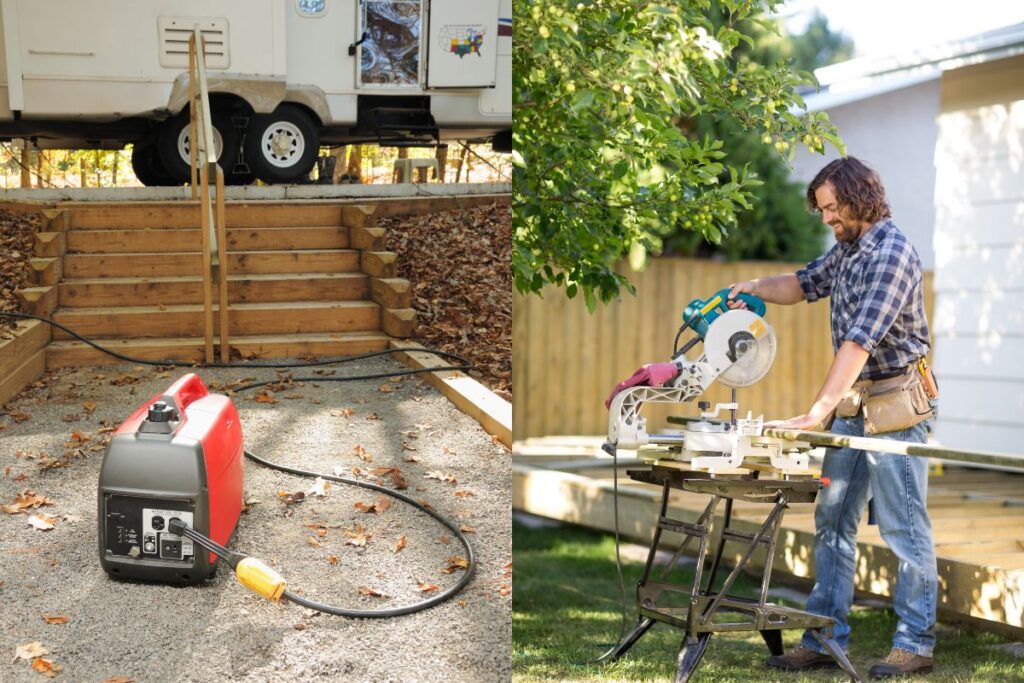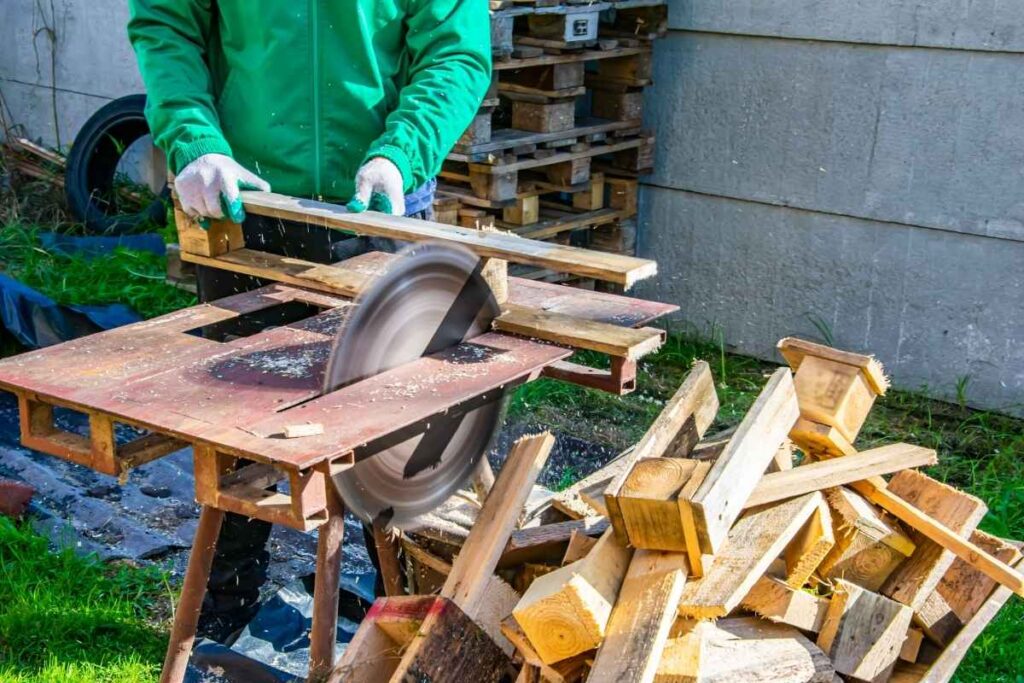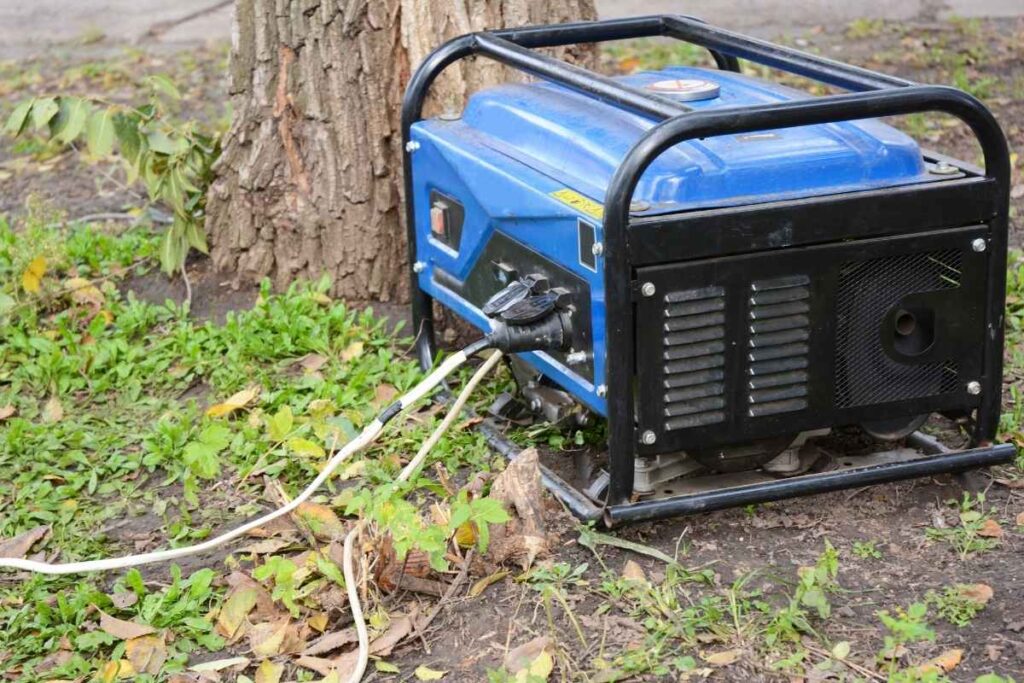A generator with a minimum of 3000 watts is needed to run a table saw. For larger table saws, consider a 5000-watt generator.⚡
Choosing the right generator for your table saw is crucial for efficient operation. Table saws, essential tools for woodworking, demand significant power, especially during startup. Motors in table saws often require a higher surge wattage to start, even if their running wattage is lower.
A 3000-watt generator typically suffices for most table saws, but larger or more powerful models may need up to 5000 watts. Always check the specific power requirements of your table saw to ensure optimal performance. Investing in a suitable generator prevents operational interruptions and maintains safety in your woodworking projects.

Why Do You Need a Generator for a Table Saw?
Sometimes, there’s no power outlet near where you’re working. Picture this: you’re in the middle of a garden, building the coolest treehouse ever🌳🏠, but there’s no electricity. That’s where a generator comes in! A generator gives your table saw the power it requires when there’s no plug around.
How Much Power Does a Table Saw Use?
Now, every table saw is a little different, just like how you and your best friend might have different favorite snacks! Some table saws use less power (like having a snack), and some use a LOT of power (like eating a whole pizza🍕)! Typically, table saws use anywhere from 1,200 to 5,000 watts to run.
Different Table Saws, Different Power Needs
Table saws come in different types. The most common types are benchtop, contractor, cabinet, and hybrid table saws.
Benchtop table saws are small and portable. Contractor saws are larger and offer more power. Cabinet saws are heavy-duty and very powerful. Hybrid saws combine features of both contractor and cabinet saws.
Let’s break down the power requirements of different table saws:
- Small table saws: These are like mini ninjas. They use less power, around 1,200 watts. Benchtop saws fall under this category and usually need around 1,200 to 1,800 watts of power.
- Bigger table saws: These require more power, around 1,500 to 2,000 watts. Contractor and hybrid saws are kind of bigger table saws. Where contractor saws often require 1,800 to 2,400 watts, and hybrid saws require 2,000 to 3,000 watts.
- Super-powerful saws: These are the champions of cutting and require up to 2,400 watts or more. Some cabinet saws fall under this category and generally use 3,000 to 5,000 watts.
Always check the saw’s manual for exact power needs.

The Role of Horsepower (HP) in Power
You’ve probably heard of horsepower, right? It sounds cool, like how fast a horse can run. 🐎 Well, table saws also have horsepower, which measures how strong they are. A stronger saw (with more horsepower) needs more watts, just like a fast horse needs more energy!
What’s an Amp and Why Should You Care?
An amp is like a water pipe. The bigger the pipe, the more water can flow through. For a table saw, the amps tell you how much electricity is flowing into the saw. Bigger table saws need more amps, just like a big hose needs more water. Most table saws need between 10 and 15 amps.
Understanding Generator Basics
Generators come in various types. There are portable, standby, and inverter generators.
Portable generators are small and easy to move. Standby generators are large and stay in one place.
Inverter generators are quiet and efficient. Each type has its own advantages.
Choosing the right one depends on your needs.
A few key specifications are important for generators. These include watts, amps, and voltage.
Watts measure the power output. Amps measure the current flow. Voltage measures the electrical potential.
Knowing these specs helps in deciding the right generator.
The Big Question: How Big of a Generator Do You Need?
Now comes the fun part! How big of a generator do you need? Well, it depends on your table saw. Remember those watts we talked about earlier?
You’ll need a generator that gives you at least that much power, but there’s a catch! Table saws often need extra power to start up, which we call “starting watts.”
A table saw needs more power to start. This is called starting watts. After it starts, it uses less power. This is called running watts. A 2 HP table saw needs around 4500 starting watts. It uses about 1800 running watts.
Check your tool’s manual for exact numbers.

How to Calculate the Right Generator Size?
Are you thinking about how to calculate the generator size? Don’t worried! It’s not hard, I promise! 😊 Here’s a quick formula:
- Find out how many watts your table saw uses when it’s running.
- Add about 50% more watts for the starting boost.
- Pick a generator that gives you at least that total.
For example, if your table saw uses 2,000 watts, you’ll need at least 3,000 watts to cover both running and starting power.
Generators also need to power other tools. Always add up all the running watts. Make sure your generator can handle the total. It’s best to choose a generator with extra capacity. This helps avoid power drops.
Always follow safety guidelines. Use a generator with enough power for all your needs.
Starting Watts vs. Running Watts (It’s Important!)
Okay, this might sound tricky, but it’s important. Imagine a car that requires a big push to start, but once it’s going, it’s easy to keep rolling.
The same thing happens with table saws!
- Starting watts are like that big push. The saw needs more power just to get going.
- Running watts are the steady amount of power to keep the saw spinning.
Portable vs. Standby Generators: Which One to Choose?
If you’re only using the generator every once in a while, a portable one is your best friend! You can move it around, like a backpack full of power. But if you use your table saw often in places without power, you might want a permanent generator that stays in one place, like a loyal dog 🐕 guarding your tools.
Pros and cons of portable vs. standby generators
| Portable | Standby | |
|---|---|---|
| Transportability | Easy to move | Usually fixed in one place |
| Power | Usually small size used for small jobs | Big Power Generators can cover the whole house |
| Sound | A bit noisy | Comparably quieter as they use sound canopy |
| Start | Portable generators need manual start | Standby generators start automatically during power loss |
| Price | Usually less expensive | Expensive |
| Good for | Camping lights up or for running small applications | Standby generators can run multiple devices at once |
Which one is suitable for table saws?
Table saws require a lot of power. A portable generator may struggle to provide enough power. Standby generators are better for heavy tools. Check the wattage of your table saw. Compare it with the generator’s capacity. Portable generators may work for short tasks. Standby generators are better for long-term use.
Fuel Types And Efficiency
A generator sized at 3,000 to 5,000 watts can efficiently run a table saw. Fuel types like gasoline or propane impact generator efficiency and runtime.
Gasoline Generators
Gasoline generators are very common. They are easy to find and use. Gasoline is usually cheap. These generators can power many tools. But they can be loud and need regular refueling. Gasoline generators can run a table saw easily. Always check the generator’s wattage before using it.
Propane And Diesel Options
Propane and diesel generators are good choices too. Propane burns clean and stores well. Diesel generators are very efficient. They can run for longer periods. Both types are more fuel-efficient than gasoline. They can easily power a table saw. Always ensure the generator meets the saw’s power needs.
Maintenance And Safety Tips
Selecting the right generator is crucial for running a table saw efficiently. Prioritize generator maintenance and safety to prolong its lifespan and ensure reliable operation.
Regular Maintenance
- Check the oil level before every use.
- Clean the air filters weekly.
- Inspect the spark plug for wear and tear monthly.
- Tighten all bolts and nuts regularly.
- Lubricate moving parts to prevent rust.
- Keep the generator clean and dry to avoid damage.
Safe Operation Practices
- Always use the generator outdoors in a well-ventilated area. It’s like playing outside instead of indoors because fresh air is better!
- Check the fuel. Make sure your generator has enough gas before you start working. No gas, no power!
- Never refuel the generator while it is running. It may cause serious injuries.
- Keep the generator away from flammable materials to avoid any unwanted hazards.
- Use heavy-duty extension cords for connecting the table saw.
- Do not overload the generator. It’s like carrying too many toys—it can break!
- Follow the manufacturer’s guidelines for safe operation.
Can a Generator Handle More than Just a Table Saw?
Yes! 🎉 Generators are like multitasking superheroes. You can plug in other tools or even lights, but remember not to overload it. If you’re powering a table saw and other things, make sure your generator is strong enough for all of them.
FAQs: How Big of a Generator is Needed to Run a Table Saw?
What size generator to run table saw?
It depends on the wattage of the table saw you want to run. Typically, table saws require 1200–2400 watts. Therefore, you can use a generator with at least 3,500 watts. Ensure it provides stable power output.
Will a 2000 watt generator run a table saw?
A 2000-watt generator can run a table saw, but it depends on the saw’s starting and running wattage. Most table saws require around 1800-2000 watts to start, so check your saw’s specifications.
What happens if I use a small generator?
If the generator isn’t strong enough, your saw might not start, or worse, the generator could overload and stop working.
How do I know my table saw’s wattage?
Check the user manual or the label on the saw itself. It will tell you how many watts it uses.
Can a generator power other tools at the same time?
Yes, but make sure your generator can handle the combined wattage of all the tools you’re using.
What fuel do I use for a generator?
Most generators run on gasoline, but some can use diesel or even solar power.
Conclusion
In a nutshell, the size of the generator you need to run your table saw depends on how powerful your saw is. Most table saws need around 1,200 to 2,400 watts, but don’t forget to add extra watts for starting power!
A portable generator is perfect for occasional use, while a permanent one works best for frequent projects.
Remember to follow safety tips and keep your generator happy and healthy, so it can keep powering your awesome woodworking projects! 😊👏
Recent Posts
Woodworking in 2025 is all about efficiency, precision, and smart technology. Whether you're a beginner or a seasoned craftsman, having the right tools can make all the difference. Here are the top 7...
Ever tried drilling into a piece of wood only to end up with a splintered mess or a wobbly hole? Yeah, it's more common than you think. Wood might seem like an easy material to work with, but...

